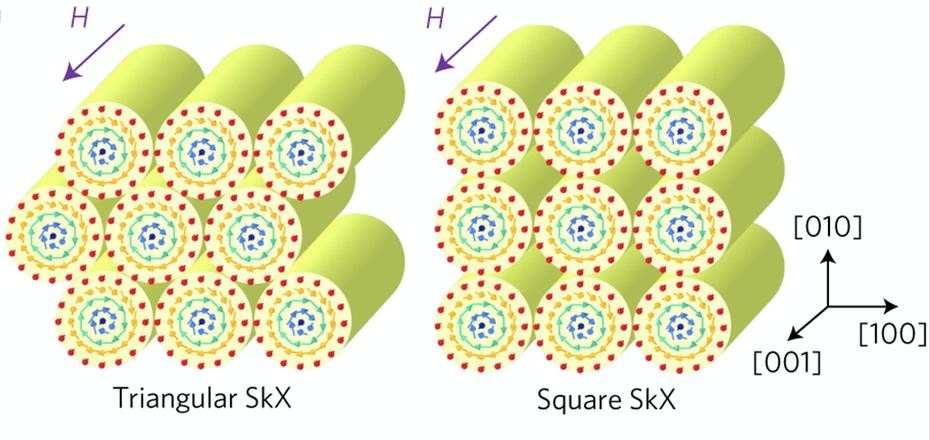Sep 21 2016
 Triangular-lattice (left) and square-lattice (right) skyrmion crystals. (Copyright: Nature Materials)
Triangular-lattice (left) and square-lattice (right) skyrmion crystals. (Copyright: Nature Materials)
Skyrmions are electromagnetic vortices that can be used for spintronics. A team of scientists from EPFL have recently discovered a material that has the potential to develop stable skyrmions in varied temperatures, showing the potential to be suitable for building devices.
Skyrmions were recently discovered to exist in specific magnetic materials. The electromagnetic properties of these nanosized vortices are promising as they can be used as information carriers in dense-memory, low-power devices that rely on electron spin instead of charge, a next-generation field of “spintronics”.
A compound capable of producing stable skyrmions that can be used for applications has been recently identified by EPFL scientists. The research has been published in Nature Materials.
For many years, researchers have been trying to develop stable skyrmions despite the fact that they cannot be easily controlled. Another factor to be considered is temperature, skyrmions have appeared only in a narrow temperature range that does not seem to be practical for applications.
A material comprising of skyrmions that are stable even when the temperatures are high has been discovered by the Laboratory for Quantum Magnetism of Henrik Rønnow at EPFL in collaboration with colleagues at RIKEN (Japan) and Jonathan White at the Paul Scherrer Institut (Aargau).
The material is made up of non-toxic, abundant, and cost-effective elements such as manganese, zinc, and cobalt. In this material, skyrmions are observed at temperatures up to 130°C, which is much above room temperature.
However, for use in practical applications, the device is expected to work through a variety of temperatures both below and above room temperature.
The researchers discovered that cooling the material at reasonable rates enables the skyrmions to remain stable at lower temperatures.
In practice, this means we can start with a compound where skyrmions stabilize, say, below 400 K (130°C), and then, as long as we cool it moderately quickly, they will be metastable at any temperature below that, which is perfect for applications.
Henrik Rønnow, EPFL
A more basic peculiarity is displayed by the material. Generally, when skyrmions appear they develop a type of triangular lattice. However, in this material the skyrmion lattice changes into a square-like lattice.
Ignoring earlier predictions, this is considered to be a first for the field. “It opens a new field of research into the lattice types possible for skyrmions,” says Rønnow.
This research represents a partnership between EPFL, the Paul Scherrer Institut, RIKEN, and the University of Kyoto.